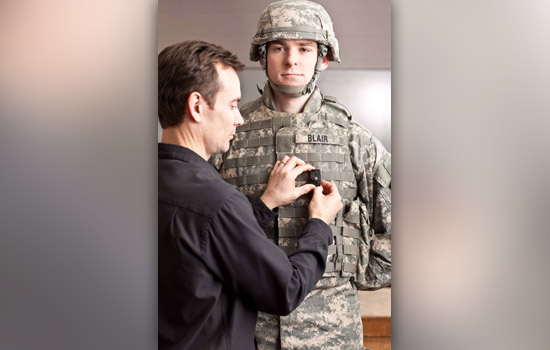Andrew Blair Ranked Fifth on the U.S. Army ROTC Order of Merit List
RIT cadet is recognized for top-10 designation among 5,600 cadets nationally
John Myers
Army ROTC cadet Andrew Blair (right) was recently recognized as one of the top cadets in the country on the Army’s Order of Merit list. The fifth-year mechanical engineering major worked with David Borkholder (left), professor of electrical engineering, on developing a blast gauge to measure blast impact on soldiers in the field.
Among the 5,000-plus Army ROTC cadets across the country, Andrew Blair is considered one of the best.
Blair, an Army ROTC cadet from Rochester Institute of Technology, found his name in the number five spot on the Army ROTC Order of Merit list, a prestigious ranking of senior cadets from the 273 host universities across the country. The list is compiled by the U.S. Army Cadet Command based at Fort Knox, Ky.
The ranking is determined by a combination of academics, strong athletic performance in the Army physical fitness test, college athletic participation and leadership in ROTC training. Cadets are also assessed on their performance at the Leader Development and Assessment Course, a five-week intensive training where cadets are evaluated in the areas of land navigation, weapon familiarization, cultural awareness, situational training and garrison operations.
“Cadet Blair truly personifies the warrior ethos. He is a citizen soldier whom others try to emulate,” says Maj. Edward Whitaker, professor of military science for the RIT Tiger Battalion. “Andrew’s immense dedication and attention to detail enabled him to excel in all military tasks and stand out from his peers.”
Blair, a fifth-year mechanical engineering major in RIT’s Kate Gleason College of Engineering, has a cumulative GPA of 3.8. He has held leadership positions in the RIT Tiger Battalion. In his junior year he was company commander, overseeing 50 of his peers within the unit. Currently he serves as tactical officer, one of the top command positions cadets can attain. One of his roles in this position is to prepare and train future participants for the Leadership Development and Assessment Course.
“Traditionally this battalion has always been different,” says Blair. “The caliber of training here has enabled me to succeed and achieve as much as I did.”
Blair is also part of an RIT research team that developed a blast gauge device to monitor a soldier’s exposure to blasts in warfare. Working with David Borkholder, an associate professor of electrical and microelectronic engineering, he helped to design and test the data-logging device that measures pressure, resulting head acceleration and time to help correlate blast events with injuries, to eventually improve care for soldiers.
“Andrew was an incredible asset to our team,” says Borkholder. “He brought insight into military operations coupled with a strong engineering talent which was indispensable to the development of the blast gauge.”
Positioning on the Order of Merit list determines a cadet’s priority in being chosen for the limited number of active duty positions, and it increases the cadet’s chance of getting the branch of occupational specialty of choice. Blair, who will be commissioned as a second lieutenant and graduate early from RIT in February, expects to begin training at the Army’s Engineering Officer Basic Course, a four-month training program at Fort Leonard Wood in Missouri.
“Sometime between now and then, I’ll find out what post and unit I will be going to,” says Blair, who was raised in Corry, Pa., just outside of Erie. He has requested being stationed at Fort Bragg, N.C., or a base in Europe.
RIT’s Tiger Battalion had several other seniors achieve high rankings in the Order of Merit list. Those cadets in the top 20 percent of the listing also earn the designation of Distinguished Military Graduate. This year, there are 1,129 Distinguished Military Graduates across the country. Nine of the 18 senior cadets from RIT on the Order of Merit List received this designation including Blair, and peers Edward Casey, Ian Scofield, Jacob VanDuyne, John Agoglia, Justin Hopkins, Jacob Dorpfeld, Brian Rook and Jeremy Fobes.
“This is great recognition for the battalion,” Whitaker says. “The commander of the regional brigade recognizes it; it gets a lot of notoriety. RIT becomes the school to beat. It puts us on a higher pedestal, and we’re looked upon by our peers for that, which is really good for us and the program.”














